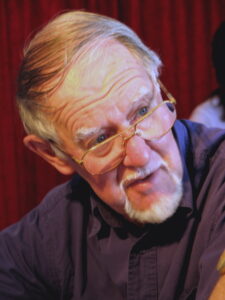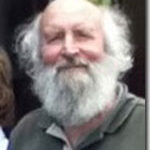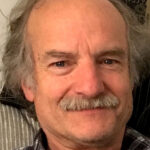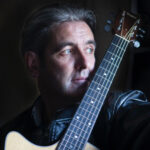Colin Blundell, Jim Kacian, Kim Richardson,
Sean O'Connor, Stephen Henry Gill (Tito)
A Leap in the Light
Tributes to David Cobb, 1926-2020

Editor’s Note: When I first heard that David Cobb—English-language haibun pioneer, lauded haiku poet, co-founder of the British Haiku Society, educator and general haikai statesman—had passed away peacefully at his home in Shalford, Essex, England, on November 6, I did what many others no doubt did as well: I reached for his books. Although I own only a handful of the nearly two dozen volumes that David published over his long life, I was happy to have what was on hand, since they allowed me to experience his voice once again. David’s work resonates, combining a quiet wisdom with astute observation, erudition, empathy, and wit. Many of his haibun also exhibit David’s true appreciation of his surroundings, drawing deeply from the history and culture of his native England.
A good example of this is his first book of haibun, The Spring Journey to the Saxon Shore. Published in 1997 and revised in 2003, Spring Journey recounts a five-day bike ride across East Anglia. The 8,000-word travelog echoes Basho’s Oku-no-hosomichi (often translated as Narrow Road to the Deep North), especially in its historical references and allusions. At each stop on his bike ride, David plumbs the local histories, from notable sites (castles, churches, shrines, etc.) to the region’s poets, writers, witches, painters, kings, and revolutionaries. (In the village of Ixworth, not only does he remember a local poet, Robert Bloomfield, who “wrote in these parts an ode about smallpox,” but he even has an imaginary conversation with him.) In the book’s introduction, David admitted that his aim was “rather like Basho’s”:
“Having immersed himself in the lore and literature of his country for the best part of forty years, he [Basho] wanted to visit all the places he had read about (literary ‘pillow-places’ or uta-makura). Presumptuous as it may seem, I cannot deny wanting to raise all the ‘great ghosts’ I could conjure conveniently from a small piece of England. The idea is, of course, to create the impression that one is never alone, not even in an empty landscape, if one tries to be aware of the generations before us who have experienced their own solitudes in the same locations.”
To be aware of David’s place in the landscape of haiku and haibun is to have someone with whom, through his works, we can still have a rich, enlightening conversation. (Links to some of his haibun from past issues of cho are at the end of this tribute.) And those who knew David well have the additional benefit of being able to relive their memories of him. Below, several of David’s friends offer brief tributes to a man who left a legacy that, like his “great ghosts,” will long endure.—RY
Colin Blundell | Jim Kacian | Kim Richardson
Sean O’Connor | Stephen Henry Gill (Tito)
Haibun for David Cobb—World-man
By Colin Blundell
Shiki said that to write a haiku a good mental discipline is to look down at the violet at your feet and then up at the distant mountain. David’s version of this might have been to take infinite care of a little enclosed patch of soil in Shalford, Essex, UK, and then canoe up-river in Borneo in order to inspect the local schools, as he did. Or even go on a ‘Spring Journey to the Saxon Shore’.
National Service tank patrols in Germany, Egypt, & Palestine at the end of the Second World War, teaching German in Newark Grammar School, working for the Unesco Institute for Education in Hamburg running courses several times in Bursa, Turkey, on Matching East & West, eleven years teaching German in Thailand, designing English as a Second and Foreign Language courses took him to France, Greece, Ghana, and the Middle East (especially Jordan)—all contributed to what David called his large ‘world outlook’. His quietly conscientious organisational flair, learned over his years as ‘world-man’, enabled him to build relationships both nationally and internationally.
Flying above Alaska in 1977 on a professional pedagogic visit to Japan, he discovered the idea of haiku in a flight information dossier hanging on the back of the seat in front of him. He seized upon the opportunity, as he saw it, of being able to establish a quick rapport with his hosts by referring in conversation to what he had discovered up in the air.
Later, greatly influenced by Joan Giroux, he was advised by Bill Higginson to find out what was behind haiku sensibility and to spend ten years practising before ever letting a haiku loose on the world. Then came the birth of The British Haiku Society in 1990 and very soon afterwards the re-invention of haibun.
Our families spent quite a lot of time together, when he and I cooperated over many early haiku projects. We went to the International Haiku Conference in Romania in 1995; from a street in Sighişora he picked up a small sandstone with three white lines of chalk sunk in it and gave it to me: ‘It’s a ‘haiku stone’, he said. Never mind what else happened in Romania, that, for me, is quintessentially ‘David’ as reflected in this haiku:
an aimless stroll pockets that slowly fill with small round stones
Once, lunching together in a Thai Restaurant in Holbeach, Lincolnshire, UK, I was mighty surprised when he suddenly burst into what I imagine was fluent Thai with the owner who was, of course, charmed. He had a facility for charming the most unlikely people.
The last time I saw a fading David in Shalford he seemed strangely moved by a three-liner I wrote to a fixture in his sitting room.
black hand on the wall – its bright jewel slipping down
He wrote only when he had been ‘moved or touched by a concrete experience, usually simply noticing what comes—it had always been like that—a brain habit. I think about the delivery and the impact more than anything…’ And so he gave me what is probably one of his last haiku.
home and whole again at fig tree lawn
in the little garden in Shalford where the last offshoot from an Okinawa red hibiscus he smuggled from Japan in his holdall in the late 1970’s was then giving up the ghost. It’s not too much to say that a green & potent part of me has died too.
Notes:
Joan Giroux wrote The Haiku Form (1974). The Haiku Foundation has it here. It’s a very sound introduction to the writing of true haiku.
Bill Higginson’s books include The Haiku Handbook (1985, co-authored with Penny Harter), Haiku World (1996), and The Haiku Seasons (1996). The purpose of reading & writing, he wrote, is ‘…in sharing moments of our lives that have moved us, pieces of experience that we offer or share as gifts…’
For more about James Hackett, see Hackett Haiku: hacketthaiku.com.
This haibun offering is derived from a longer article in Blithe Spirit, Volume 31.1.
Remembering David Cobb
By Jim Kacian
I had the good fortune to be counted among David’s many friends. This might have taken the form of a merely collegial regard between poets, but we both took opportunities to make it more than that. We appeared on the same programs at many, especially European, conferences, and in each instance found time to share at least one extended walk, often to admire some site of local interest or architecture. In Ghent, for instance, we went together to view the altarpiece in St. Bavo’s Cathedral, and David proved to have a considerable knowledge of the early Flemish masters. In Vadstena he knew the local religious history, citing the founding of the Bridgettine Order at the Vadstena Abbey; as well as its lay history, noting that the Vadstena Town Hall is the oldest in Sweden. To David these were not guide book facts that could be looked up and readied for the occasion, but things he actually knew, contained within the larger sweep of the history of (especially) northern Europe that was his passion. This was never more evident than when he hosted me for several days in the summer of 2015 and guided me through the rich history of his beloved Essex and the Saxon shore. Needless to say he also was on close personal terms with every bookshop within that wide swath of England, and we visited every last one. Haiku, history, books—I will remember with great admiration David’s energy, passion and commitment to the things he loved, as well as his self-determination to live all his long life on his own terms to the utmost degree possible. Given the proximity to my own demise, I know I will call upon David’s example for inspiration in time of need, and expect that he, as he did so often in haiku, will deliver.
I offer here a link to a presentation given by David at the International Haiku Conference at Ghent on “Place Names in English-language Haiku,” what the Japanese call utamakura, combining several of the interests mention above. Click here to view it on The Haiku Foundation website.
“I Jumped at the Opportunity of Working with Him”
By Kim Richardson
Having not long started Alba Publishing, I had the great pleasure of publishing David Cobb’s 2013 haibun collection, Marching with Tulips, and its companion, explanatory volume, What Happens in Haibun. David had managed to secure a grant from the Sasakawa Foundation to finance the publication of these books and, at a British Haiku Society AGM [Annual General Meeting], asked me if I would be the publisher. I jumped at the opportunity of working with him.
Working with David was a great delight, and a master class in haibun. We spoke often on the phone and met in person a few times while these books were in editing stages. The last time I remember seeing him was at a memorable evening of haibun readings at the Poetry Society in London in March 2015. The late Ken Jones came up from Wales and read from the collection that would become Gone Away, as did other ‘haibuneers’ from the UK, including David, who read from The Spring Journey to The Saxon Shore.
David’s immense knowledge, wisdom, and deep kindness and generosity will be missed. But he leaves a remarkable and lasting legacy in the shape of his published works, and the many friendships that he made along his haiku journey.
“A Kind of Father Figure”
By Sean O’Connor
David Cobb’s contribution to the writing of haiku, and his energetic promotion of the form, is widely known and respected. He was also a leading pioneer of the haibun. Back in the 1990s there were but a few of us with a keen interest in developing haibun writing. Many of us looked to David for mentorship and guidance, and he shared his expertise freely.
David made a number of trips to Ireland during the ’90s to spend time with Irish haiku enthusiasts such as Jim Norton, Gabriel Rosenstock, and myself. He was part of a small group of haibun writers from the British Haiku Society who traveled here. In October 2000, for example, David Cobb, Ken Jones, George Marsh, Jane Whittle, and I gathered for a haiku weekend retreat in Wicklow, Ireland, organized by Jim Norton. Much of our time together was focused on haibun as well as haiku.
David was great company. For the most part a quiet man, though not shy, most of us saw him as a kind of father figure. There was something of a diplomat about him, an erudite gentleman with a dry understated wit and a composed demeanor.
I find it both surprising and fitting that the last haibun of David’s to be published appeared in The Haibun Journal, October 2020. “Snow in Advent,” winner of the Genjuan International Haibun Contest, was printed one month before he passed away peacefully at the age of 94. He left us a remarkable legacy.
A Tribute for David Cobb
By Stephen Henry Gill (Tito)
In 1990, after my return from six months in India, a man in a tweed jacket, cardigan and colourful shirt came up to me at an event in the Japanese Embassy on Piccadilly and introduced himself, saying, “Hello, I’m David Cobb. We’ve been trying to get in touch with you, for we’ve just begun a haiku society in the UK and I’m its secretary.” Apparently, BBC Radio, for whom I had already made a number of haiku-centred radio features, had withheld my contact details, but now, here we were, face to face, both with a lot of haiku writing behind us, aware of Reginald Blyth and his oeuvre, fans of certain season words (such as uguisu, bush-warbler and kirigirisu, grasshopper). We chattered away, swapped addresses, and before long I too was a member of the British Haiku Society, working alongside David, Dee Evetts, James Kirkup, and Colin Blundell on its Committee as Events man. The following year, I organized and staffed a British Haiku Society tent in the Japan Festival in Hyde Park and thousands came. We were purveying only words and silence, though, and honestly had little to sell to the exotica-seeking, snack-hunting crowds, but when David visited the booth later in the day I was able to report that the only thing a member of the public had actually bought from us had been David’s haiku with a sumi-e illustration by my wife brushed onto a shikishi poem-card!
every movement the grasshopper makes a leap in the light
The last line of this haiku also became the title of his first haiku collection, A Leap in the Light, published the following year. From that day onwards, I realized that David’s haiku were going to be well-loved. And that is how it turned out. Why? Many reasons, including a considerable literary genius, a certain turn of phrase, but I believe it was his effective use of English season words that really marked him out. He came out to Japan many years later (2004) to give a talk to my own Hailstone Haiku Circle here in Kansai on that very subject. A haiku of his from that talk:
frost holds: Friesians in the byre chew steam
David and I shared an interest in haibun. Fred Schofield and I had made a lengthy haibun account of a journey on foot along Offa’s Dyke on the Wales-England border, In the Autumn Wind, for BHS during our Basho Tercentenary celebrations in 1994. Then, in 1997, David produced his own haibun account of a bicycle journey in Eastern England, The Spring Journey to the Saxon Shore. The word ‘haibun’ was getting out!
Both David and I have had the privilege over the years to collaborate with the Penguin Classic Basho translator, Nobuyuki Yuasa, and in subsequent years we both managed to institute haibun contests with Nobuyuki. First, David & Nobuyuki started a BHS one in 2002, the Nobuyuki Yuasa Prize. Later, Nobuyuki and I started the Kikakuza and then the Genjuan International Haibun Contests out here in Japan. It was thus true ‘poetic justice’ for David, at the ripe old age of 93, to win the Grand Prix in the Genjuan 2020 Contest, just 6 months before he passed away, for a piece, “Snow in Advent,” which begins with this haiku:
hurry up hurry dusty cobwebs all over the sledge
It is an account of waking up to an overnight fall of heavy snow and written in a mode beautifully poised between exuberance and serenity. David’s son, Thomas, later told me in a letter that David had been “thrilled with winning the Genjuan award and told all his friends and family about his achievement. … I think he felt that winning the prize showed he still had the touch.” Indeed, right to the very end, he certainly did! As judge, I had myself been overjoyed, of course, to find out that this old friend and pioneer was the author. Nobuyuki was, too.
For the past two decades or more David Cobb had been one of the most prolific and consistent writers of English haibun and should be remembered for his wonderful contribution to the budding genre. Luckily, I have many fond memories to treasure, many of them humorous. Haiku is fun, and we had a lot of fun together. I am missing him already.
Haibun by David Cobb
Below are links to a few of David’s haibun published in earlier issues of contemporary haibun online.
About the Contributors

Colin Blundell was born in 1937. “While my father was fighting in some war, I was left to my own devices between 1940-45, which is where my DIY mentality began,” he says. He has written “proper poetry” since the 1950s and, with Alan Watts, came to haiku in 1963. An early member of the British Haiku Society and now its president, he edited the society’s journal, Blithe Spirit, for 14 years on and off.

Jim Kacian is the founder and president of The Haiku Foundation as well as chairman of its board; founder and owner of Red Moon Press; editor in chief of Haiku in English: The First Hundred Years (W. W. Norton, 2013); and author of more than 20 books of poetry, primarily haiku. He is also the founder and current publisher of the contemporary haibun print series and contemporary haibun online.

Kim Richardson’s work has appeared in various journals over the years and been anthologised, translated, and honored with awards. His first collection, Night Ferry (Alba Publishing, 2018) was shortlisted for a Touchstone Distinguished Books Award. Kim is an assistant editor of The Haibun Journal, and, as Alba Publishing, publishes collections of haiku and related forms.

Sean O’Connor is the founder and editor of The Haibun Journal, a judge of the Genjuan International Haibun Contest, and has been writing haibun and haiku for 30 years. His first solo collection, Let Silence Speak (Alba Publishing, 2016), was shortlisted for the Touchstone Distinguished Books Award 2016. His latest book, Even the Mountains: Five Years in a Japanese Village (Alba Publishing, 2018), has been well received by reviewers. He currently lives in rural Ireland.

Stephen Henry Gill (haigo: Tito) began writing haiku and haibun in 1972 and now lectures on Haiku in English Literature at Kyoto and Ryukoku universities. A former member of the British Haiku Society Committee (1991–1995), he founded the Hailstone Haiku Circle, Kansai, in 2000 and is co-founder and judge of the Genjuan International Haibun Contest. He edited Rediscovering Basho (Global Oriental, 1999).

What a beautiful tribute package for ‘Old Turnip’ 古蕪 (Kobu). I will send this link to David’s family and put it onto the Icebox, too. Nicely devised, Rich!
A wonderful collection of tributes to one of the ‘best of British’. I met David only once and it was highly enjoyable. We spent the entire time talking cricket!
For the record, I believe David passed away at his home in Shalford, Essex, and not at Harrow (which was where he was born).
Thank you, Stephen! That correction has been made.